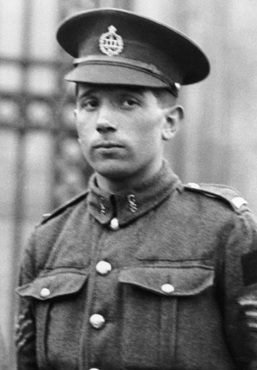Cpl
Colin Fraser Barron
Information about birth
|
Date of birth: 20/29/1893 |
|
Place of birth: Boyndie, Banffshire, Scotland, United Kingdom |
General information
|
Profession: Teamster |
|
Religion: Presbyterian |
Army information
|
Country: Canada |
|
Force: Canadian Expeditionary Force |
|
Rank: Corporal |
|
Service number: 4017 |
|
Enlistment date: 05/04/1915 |
|
Enlistment place: Toronto, Ontario, Canada |
|
Units: — Canadian Infantry, 3rd Bn. (Toronto Regiment) (Last known unit) |
Information about death
|
Date of death: 15/08/1959 |
|
Place of death: Sunnybrook Hospital, Toronto, Ontario, Canada |
|
Cause of death: Death post-war (unrelated) |
|
Age: 65 |
Cemetery
|
Prospect Cemetery Plot: Veteran's Section 7 Row: N/A Grave: 3562 |
Distinctions and medals 3
|
British War Medal Medal |
|
Victoria Cross Medal |
|
Victory Medal Medal |
Points of interest 4
| #1 | Place of birth | ||
| #2 | Enlistment place | ||
| #3 | Location of medal-earning event | ||
| #4 | Place of death (approximate) |
My story
Colin Fraser Barron was born in Boyndie, Banffshire, Scotland (sometimes specified as “Mill of Boyndie” or “Baldavie”, depending on the source). He was the son of Margaret (Maggie) Walker Barron. Barron grew up with his grandparents Joseph and Mary Reid. He emigrated to Canada in 1910 and made a living as a teamster in Toronto. On 25 January 1915 he enlisted at Toronto and joined the 35th Battalion as a private (some documents state his date of enlistment as 5 April 1915). Private Barron arrived in France on 17 July 1915 and joined the Canadian Infantry, 3rd Bn. (Toronto Regiment), part of the 1st Canadian Brigade, of the 1st Canadian Division. By July 1917, he had been promoted to corporal and served as a Lewis gunner with “D” Company.
At 6 a.m. on the morning of 6 November 1917 the 1st Canadian Division attacked northwest of the ruined village of Passchendaele. The 3rd Battalion attacked on the left, and the 1st and 2nd Battalions on the right. There was no contact between the attacking troops on the left and right due to the boggy land separating them. The attack of the 3rd Battalion was checked by machine gun fire from the German strongpoint at Vine Cottage. It is here were Corporal Barron earned his Victoria Cross.
His citation states the following: “For conspicuous bravery when in attack his unit was held up by three machine-guns. Corpl. Barron opened on them from a flank at point-blank range, rushed the enemy guns singlehanded, killed four of the crew, and captured the remainder. He then, with remarkable initiative and skill, turned one of the captured guns on the retiring enemy, causing them severe casualties. The remarkable dash and determination displayed by this N.C.O. in rushing the guns produced far-reaching results, and enabled the advance to be continued.”
The 1st Canadian Division was able to capture its panned objectives. They were taken out of the line a few days later. In early 1918 Colin Barron was promoted to the rank of sergeant and was assigned to the Canadian Corps Lewis Gun School as an instructor. He survived the war and was demobilized in 1919. He died in Toronto, Ontario on 15 August 1958.
At 6 a.m. on the morning of 6 November 1917 the 1st Canadian Division attacked northwest of the ruined village of Passchendaele. The 3rd Battalion attacked on the left, and the 1st and 2nd Battalions on the right. There was no contact between the attacking troops on the left and right due to the boggy land separating them. The attack of the 3rd Battalion was checked by machine gun fire from the German strongpoint at Vine Cottage. It is here were Corporal Barron earned his Victoria Cross.
His citation states the following: “For conspicuous bravery when in attack his unit was held up by three machine-guns. Corpl. Barron opened on them from a flank at point-blank range, rushed the enemy guns singlehanded, killed four of the crew, and captured the remainder. He then, with remarkable initiative and skill, turned one of the captured guns on the retiring enemy, causing them severe casualties. The remarkable dash and determination displayed by this N.C.O. in rushing the guns produced far-reaching results, and enabled the advance to be continued.”
The 1st Canadian Division was able to capture its panned objectives. They were taken out of the line a few days later. In early 1918 Colin Barron was promoted to the rank of sergeant and was assigned to the Canadian Corps Lewis Gun School as an instructor. He survived the war and was demobilized in 1919. He died in Toronto, Ontario on 15 August 1958.
Sources 5
|
"Barron, Colin Fraser" (The Queen's Own Rifles of Canada Regimental Museum and Archive) https://qormuseum.org/soldiers-of-the-queens-own/barron-colin-fraser/ Sources used |
|
"No. 30471". The London Gazette (Supplement), 8 January 1918, 723. https://www.thegazette.co.uk/ Sources used |
|
Honours and Awards Citation Cards. (Library and Archives Canada, Ottawa (LAC)). https://library-archives.canada.ca/ Sources used |
|
Personnel Records of the First World War (Library and Archives Canada, Ottawa (LAC), RG 150, 1992-93/166, Box 4464 - 25). https://library-archives.canada.ca/ Sources used |
|
Snelling, Stephen. VCs of the First World War: Passchendaele 1917 (sl., Wrens Park Publishing, 2000) 266-273. Sources used |
More information 1
|
Lives of the First World War (Imperial War Museum) https://livesofthefirstworldwar.iwm.org.uk/lifestory/5561175 |
